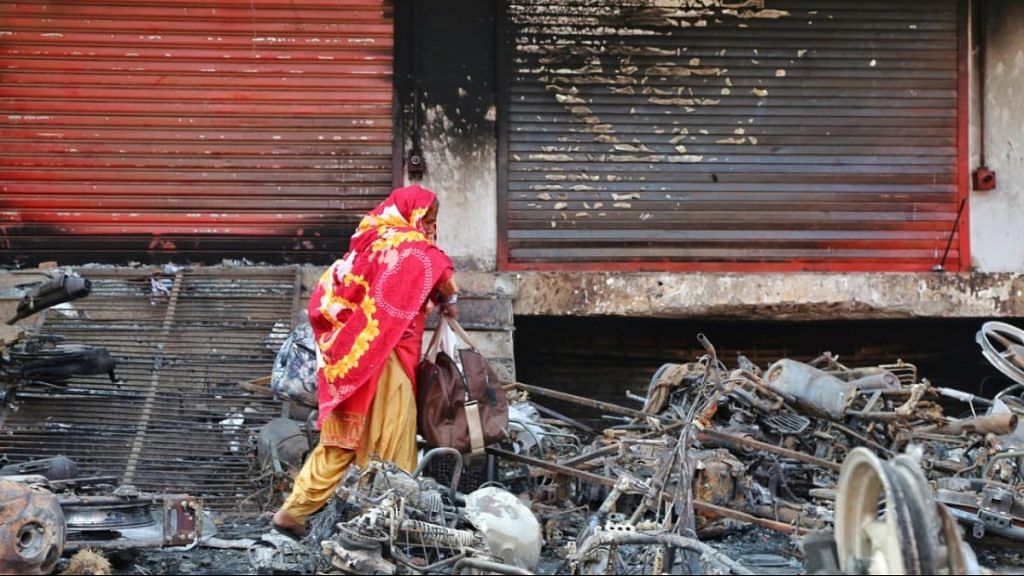New Delhi: The report of the fact-finding committee set up by the Delhi Minorities Commission (DMC) to look into the Northeast Delhi riots is replete with chilling accounts of communal frenzy.
The report, submitted to the panel on 27 June and released to the media Thursday, quotes one witness as saying that a mob invoked the 2001 Partition drama Gadar as it went on the rampage. “Several Sakeenas will be caught today,” the mob is alleged to have chanted, while also shouting “Jai Shri Ram” and “Kill the Muslims”.
Based on the India-Pakistan Partition, which unleashed a wave of communal bloodshed on both sides of the border, Gadar is a love story. It tells the story of a Muslim woman, Sakeena, who is accidentally left behind when her family migrates to Pakistan after the Partition, and a Hindu man named Tara.
The start of their romance in the movie can be traced to Tara saving Sakeena from a mob baying for her blood.
“A woman narrated how a movie based on Partition (Gadar) was referenced by the mob to attack her. She said the rioters had all kinds of weapons with them; they had lathis, swords and they kept chanting ‘Jai Shri Ram’ and ‘Mullon ko Maaro (Kill the Muslims)’,” the 130-page report submitted by the fact-finding committee, which was set up on 9 March, states.
“The rioters were yelling at the women and, saying, “Bahut see Sakeenaayein aaj pakdi jaayengi (A lot of Sakeenas [Muslim women] would be caught today),” it adds.
The report has a separate section on “women and children”, which seeks to detail multiple allegations of sexual violence against women, including by Delhi Police.
“Despite several calls made by these women to the police, in most cases they did not receive any help at all. One of the protesters at the Chand Bagh (anti-CAA) sit-in stated that Delhi Police brutally attacked and even sexually assaulted women,” the report states.
“In her harrowing account, she stated that she was being attacked by rioters at Chand Bagh and that the two men who were trying to help her were being beaten up by police. She was even witness to the police dragging a 12-13-year-old girl. She tried to protect her but failed as she was hit on the head by a stone and she subsequently fainted.
“When she regained consciousness, she saw that there were many injured women around… She recounts that it was then that the police pulled their pants down and pointed their genitals towards the women stating that they wanted ‘freedom’ and they were there to give them ‘freedom’ and that this was their ‘freedom’,” the report states.
The word “freedom”, the report adds, is used as a metaphor for sexual assault. Apart from the accounts of alleged sexual violence, the report has raised many questions about the role played by Delhi Police in the riots, with the panel concluding that they “abetted” and were “complicit” in the violence.
ThePrint reached Deputy Commissioner of Police M.S. Randhawa, the public relations officer for the Delhi Police, through texts and mail for comments on the report. This report will be updated when he responds.
Also Read: Why Delhi riots are different — what ThePrint’s 13 reporters, photojournalists saw on ground
‘Accounts of brutal violence’
According to the report, even pregnant women and young children were not spared during the violence.
In Chand Bagh, the report states, a three-month pregnant woman named Rubina “was brutally beaten up by not only the communal mob but also by the police”.
“She recalls the communal slurs and slogans of Jai Shree Ram and Ye Le Azadi when a man in police uniform tried to kill her with a stone rendering her unconscious. She was taken to Al-Hind Hospital and later to the AIIMS Trauma Centre,” the report states.
A 26-year-old woman in the final stages of pregnancy has been quoted as saying, “The mob beat me with lathis… Some kicked me in the stomach. They stopped after a while, destroyed the house, and left.” Shabana, the report adds, delivered her child the next day.
“The testimonies suggest that Muslim women were attacked on the basis of their religious identity; their hijabs and burqas were pulled off. Through the (anti-CAA) protests in Delhi, Muslim women had taken a lead role in organising and occupying public space,” the report states.
“Several narratives of women suggest that the police forces and violent mobs attacked the Chand Bagh protest site; women were beaten up by male police officers and attacked by mobs. Women have also recounted instances of acid attack by the mobs.”
The report also notes that while several places of religious significance to Muslims were attacked and suffered damage during the riots, the temples in the affected areas were “completely intact”.
“Although there aren’t many temples in the area, the fact-finding committee members found that the few that existed were completely intact. They were neither looted nor damaged,” the report states. “The residents informed the members that the Muslim majority population had kept a strict vigil to ensure the safety of these temples.”
Also Read: 20 Hindus named in fresh Delhi riots charge sheets for killing 2 Muslim brothers
